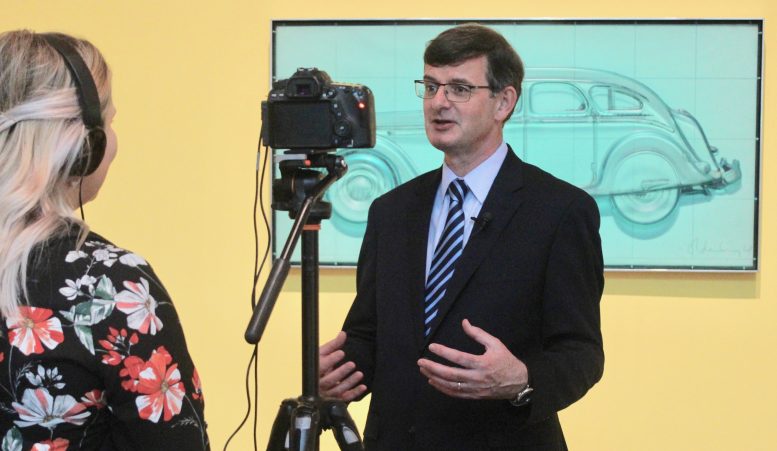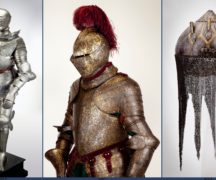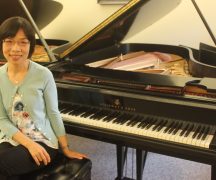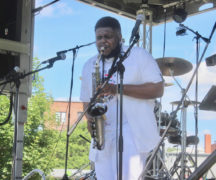By DAVID DUPONT
BG Independent News
Brian Kennedy knows why his name was on the list of candidates to direct the Peabody Essex Museum in Salem, Massachusetts.
“That museum wants to do what this one has done,” he said in his valedictory address as director of the Toledo Museum of Art recently.
The Peabody Essex “wants to be more multi-sensory,” Kennedy said. It wants to engage in arts education and visual literacy initiatives. And it’s willing to devote “incredible resources” to reaching that goal.

This was the last event of Kennedy’s nine-year tenure at the Toledo Museum. He spoke from the stage of the Peristyle, where he said, his tenure began. On that first day he gathered the staff on the stage of what he called “the most stunning space in any American museum.” He wanted to make a point. Their job was to fill seats.
The Toledo Museum attracts more than 400,000 visitors a year. From 2011-2018 it brought more than 2.4 million visitors to the region. One show Playtime brought in 135,000. That also got the museum some social media attention when a 250-pound rubber ball created for the show got loose, and bounced down through the streets of Toledo.
That’s not the only way the museum has reached out during Kennedy’s time.
The museum launched its Community Block Party in 2014. The party features food trucks, outdoor performances, dancers, circus acts, and the museum open late. This year’s party will be held July 13.
“The block party has become an expression of our involvement with the community,” Kennedy said.
The museum has also extended beyond its walls. The Sculpture Garden was installed before Kennedy arrived. Now the museum offers flashlight tours of the area. During his tenure, “Spiegel” by Jaume Plensa, a large head made up of phrases from many languages now sits on the southern edge of the museum campus where Monroe and Collingwood meet. When the museum hosted a major exhibit of Plensa’s work in 2016, works by the Spanish sculptor were positioned outside throughout the campus.
No art works have been damaged, Kennedy said. That’s because residents see this as part of their community
Play areas have added around campus, and the museum will project movies onto the wall of the Glass Pavilion. These are a prelude to what will happen on the museum grounds in the next 20 years, he said.
Kennedy said one of his favorite memories was the night in 2012 when 1,600 Girl Scouts camped out overnight in the museum, sleeping under the Rembrandts.
“That’s a lot of pizza.” The sleepover was to commemorate the 100th anniversary of the founding of the first chartered Girl Scout council in the country, after the scouting group was created in Savannah, Georgia. Florence Scott Libbey was one of the council founders. She and her husband also founded the museum, and the museum’s top position is now endowed as the Edward and Florence Scott Libbey directorship.
In 2012, Kennedy said, he asked staff to put pins into a world map for every country that was not represented in the collection. “It included whole continents,” Kennedy said.
Among the unrepresented was Australia, where Kennedy served as a museum director earlier in his career. So the museum set about filling those holes. Major exhibits featured Australian and American indigenous art.
The museum acquired a number of objects related to birds, and has special programming connected to the Biggest Week in American Birding, which draws thousands of birders to the shores of Lake Erie.
The TMA has also bolstered its holdings in digital art, which represent more than half of the art now produced, Kennedy said.
The museum hosted an exhibit of work by Kehinde Wiley, and his talk packed the Peristyle.
People need to see themselves in the collection, Kennedy said.
When the museum presented portraiture of French impressionist Edouard Manet, it complemented it with an entire gallery wall of photo portraits of local people.
Last year, it presented another international show “Frans Hals: A Family Reunion,” which brought together three parts of Dutch family portrait. At the entrance to the gallery was a collage of photos of local families.
Kennedy has promoted the concept of visual literacy. In an increasingly media-saturated world people should be able “to read, understand and write visual language,” he said.
He and other museum officials have participated in international conferences on the subject. In a partnership with Owens Corning the museum is exploring how the concepts of visual literacy can be applied to workplace safety. That could make money for the museum in the future.
The process starts with youngsters. The museum’s education center is the most used part of the museum.
When in 2011, it presented American artist Frank Stella’s irregular polygons series, it placed a play area in the middle of the gallery, so kids could construct their own polygons.
Stella, who knows Kennedy from the director’s time in New Hampshire, told him that in the past he would have objected. But having recently become a grandfather, the artist was glad to see it there.
Kennedy has recently become a grandfather, and that made the Massachusetts job more attractive. He and his wife, and son will be an hour away from his daughter, son-in-law, and granddaughter.
But he indicated that for him it was time to move on to his fifth directorship. “Some people stay a long time, and some people do a certain kind of job, set up a plan for somebody else to deliver.”
The museum has completed its $43 million Polishing the Gem fundraising campaign that helped restore the endowment devastated by the downturn in 2008.
On his last day in the office, he received the final copy of the new campus master plan. The elaborate plan would reshape the campus, building on the modest efforts of using the outside space of the 40-acre campus. One possibility would be redirecting Monroe Street to what is now parking area, so it would have a large park area connecting the museum and the Glass Pavilion.
That’s looking out 15-20 years, he said. That will be in someone else’s hands.
At the end, Kennedy wanted those present who represent all those who visit the museum to celebrate themselves and “cherish this museum.”





